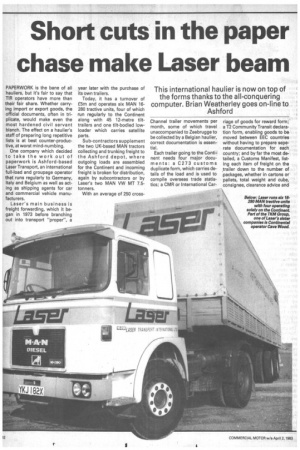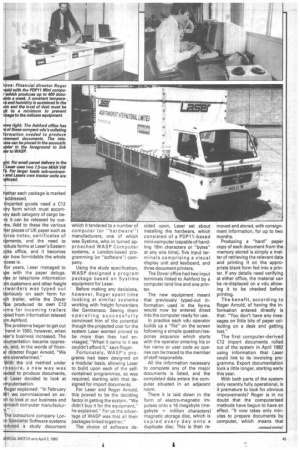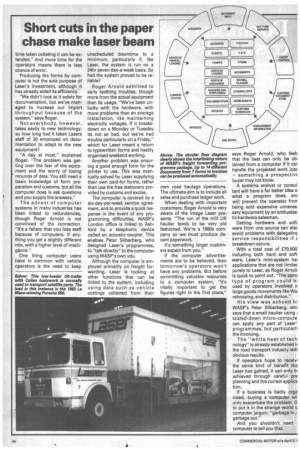Short cuts in the paper chase make Laser beam
Page 40

Page 41

Page 42

If you've noticed an error in this article please click here to report it so we can fix it.
This international haulier is now on top of the forms thanks to the all-conquering computer. Brian Weatherley goes on-line to Ashford
PAPERWORK is the bane of all hauliers, but it's fair to say that TIR operators have more than their fair share. Whether carrying import or export goods, the official documents, often in triplicate, would make even the most hardened civil servant blanch. The effect on a haulier's staff of preparing long repetitive lists is at best counter-productive, at worst mind-numbing.
One company which decided to take the work out of paperwork is Ashford-based Laser Transport, an international full-load and groupage operator that runs regularly to Germany, Italy and Belgium as well as acting as shipping agents for car and commercial vehicle manufacturers.
Laser's main business is freight forwarding, which it began in 1973 before branching out into transport "proper", a year later with the purchase of its own trailers.
Today, it has a turnover of 65m and operates six MAN 16280 tractive units, four of which run regularly to the Continent along with 45 12-metre tilttrailers and one tilt-bodied lowloader which carries satellite parts.
Sub-contractors supplement the two UK-based MAN tractors collecting and trunking freight to the Ashford depot, where outgoing loads are assembled for the Continent and incoming freight is broken for distribution, again by subcontractors or by Laser's two MAN VW MT 7.5tonners.
With an average of 250 cross
Channel trailer movements per month, some of which travel unaccompanied to Zeebrugge to be collected by a Belgian haulier, correct documentation is essential.
Each trailer going to the Conti4 nent needs four major documents: a C273 customs duplicate form, which carries details of the load and is used to compile overseas trade statistics; a CMR or International Car
riage of goods for reward form; a T2 Community Transit declaration form, enabling goods to be moved between EEC countries without having to prepare seperate documentation for each country; and by far the most detailed, a Customs Manifest, listing each item of freight on the trailer down to the number of .packages, whether in cartons or pallets, total weight and cube, consignee, clearance advice and hether each package is marked addressed.
Imported goods need a C12 itry form which must accommy each category of cargo bere it can be released by cusms. Add to these the various her pieces of UK paper such as ivice notes, certificates of iipments, and the need to .oduce forms at Laser's Eastern acks office, and it becomes ear how formidable the whole .ocess is.
For years, Laser managed to )pe with the paper deluge. .4ex or telephone information 3rrl customers and other freight
warders was typed out boriously on each form for ich trailer, while the Dover f ce produced its own C12 irms for incoming trailers )oled from information telexed Dm Ashford.
The problems began to get out hand in 1980, however, when iser's business increased. The numentation became oppresve, and, in the words of linenal director Roger Arnold, "We ere overwhelmed."
With the old method under ressure, a new way was 3eded to produce documents, id Laser decided to look at arnputerisation.
Roger explained: "In February )81 we commissioned an ex?rt to look at our business and )proach computer manufacturs."
The consultant company Lonm Specialist Software systems .oduced e study document
which it tendered to a number of computer (or "hardware") manufacturers, one of which was Systime, who in turned approached WASP Computer systems, a London-based programming (or "software") company.
Using the study specification, WASP designed a program package based on Systime equipment for Laser.
' Before making any decisions, however, Roger spent time looking at similar systems working with freight forwarders like Gentransco, Seeing them operating successfully convinced him of the potential though the projected cost for the system Laser wanted proved to be more than they had envisaged. "When it came to it we couldn't afford it," says Roger.
Fortunately, WASP's programs had been designed on a modular basis, allowing Laser to build upon each of the selfcontained programmes, as was required, starting with that designed for import documents, For Laser and Roger Arnold, this proved to be the deciding factor in getting the system, "We didn't buy it for the equipment," he explained." For us the advantage of WASP was that all their packages linked together."
The choice of software de
cided upon, Laser set about installing the hardware, which consisted of a PDP11-based mini-computer (capable of handling 16m characters or "bytes" at any one time), five input terminals comprising a visual display unit and keyboard, and three document printers.
The Dover office had two input terminals linked to Ashford by a computer land line and one printer.
The new equipment meant that previously typed-out information used in the forms would now be entered direct into the computer ready for use.
In practice each vdu operator builds up a "file" on the screen following a simple question/response sequence which starts with the operator entering his or her name or user code so queries can be traced to the member of staff responsible.
All the information necessary to complete any of the major documents is listed, and the completed data enters the computer situated in an adjacent Mom.
There it is laid down in the form of electro-magnetic impulses onto a 16 megabyte (megabyte = million characters) magnetic storage disc, which is copied every day onto a duplicate disc. This is then re
moved and stored, with consignment information, for up to two months.
Producing a "hard" paper copy of each document from the memory stored is simply a matter of retrieving the relevant data and printing it on the appropriate blank form fed into a printer. If any details need verifying at either office, the material can be re-displayed on a vdu allowing it to be checked before printing.
The benefit, according to Roger Arnold, of having the information entered directly is that: "You don't have any messages on little bits of paper collecting on a desk and getting lost."
The first computer-derived C12 import documents rolled out of the system in April 1982 using information that Laser could link to its invoicing programme. Export documentation took a little longer, starting early this year.
With both parts of the system only recently fully operational, is it premature to look for obvious improvements? Roger is in no doubt that the computerised methods have begun to have an effect. "It now takes only minutes to prepare documents by computer, which means that time taken collating it can be extended." And more time for the operators means there is less chance of error.
Producing the forms by computer is not the sole purpose of Laser's investment, although it has already aided its efficiency.
"We didn't look at it solely for documentation, but we've managed to increase our import throughput because of the system," says Roger.
Not everybody, however, takes easily to new technology, so how long had it taken Lasers staff of 30 employed on documentation to adapt to the new equipment?
"A day at most," explained Roger. "The problem was getting over the fear of the equipment and the worry of losing mounds of data. You still need a basic knowledge of form preparation and customs, but all the computer does is ask questions and you supply the answers."
The advent of computer systems in many industries has been linked to redundancies, though Roger Arnold is not convinced of the connection. "It's a fallacy that you lose staff because of computers. If anything you get a slightly different. mix, with a higher level of intelligence."
One thing computer users have in common with vehicle operators is the need to keep unscheduled downtime to a minimum, particularly if, like Laser, the system is run on a 24hr seven-day-a-week basis. So had the system proved to be reliable?
Roger Arnold admitted to early teething troubles, though more from the actual equipment than its usage. "We've been unlucky with the hardware, with more problems than an average installation, like maintaining electricity voltages. If it breaksdown on a Monday or Tuesday its not so bad, but we've had trouble particularly on a Friday," which for Laser meant a return to typewritten forms and hastily organised weekend working.
Another problem was ensuring a good enough form for the printer to use. This was eventually solved by Laser supplying their own paid-for forms, rather than use the free stationery provided by customs and excise.
The computer is covered by a six-day-per-week service agreement, and to provide a quick response in the event of any programming difficulties, WASP's London office is linked to Ashford by a telephonic device called an acoustic coupler. This enables Peter Silberberg, who designed Laser's programmes, to "talk directly" to the computer using WASP's own vdu.
Although the computer is employed primarily on freight forwarding, Laser is looking at other functions that can be linked to the system, including using data such as vehicle costings collected from their own road haulage operations. The ultimate aim is to include all sales and purchase ledger work.
When dealing with important customers, Roger Arnold is very aware of the image Laser presents. "The run of the mill UK haulier tends to be very old fashioned. We're a 1980s company so we must produce decent paperwork.
It's something larger customers expect from you."
If the computer advertisements are to be believed, then tomorrow's operators won't have any problems. But before committing valuable resources to a computer system, "It's vitally important to get the figures right in the first place," says 'Roger Arnold, who feel that the best can only be ob. tamed from a computer if it car handle the projected work roar — something a prospective buyer may not know.
A systems analyst or consul tent will have a far better idea o what a program does, anc will prevent the operator frorr being sold expensive unneces. sary equipment by an enthusias. tic hardware salesman.
Getting hardware and soft. were from one source can alsc avoid problems with delegatinE service responsibilities if z breakdown occurs.
With a total cost of £70,000 including both hard and soft. ware, Laser's mini-system ha: applications that are not limiter purely to Laser, as Roger Arnolc is quick to point out. "The same type of program could b• used by operators involved ir large goods movements like Wa rehousing, arid distribution."
His view was echoed b) WASP's Peter Silberberg, whe says that a small haulier using scaled-down micro-compute can apply any part of Laser! programmes, but particularli the invoicing.
The "white heat of tech nology" is already established h the road transport industry witl obvious results.
If operators hope to receiv• the same kind of benefit the Laser has gained, it can only bi achieved through careful pre planning and the correct applica tion.
If a business is badly orga nised, buying a computer wil only exacerbate the problem. 0 to put it in the strange world a computer jargon: "garbage in garbage out."
And you shouldn't need computer to tell you that.












































































